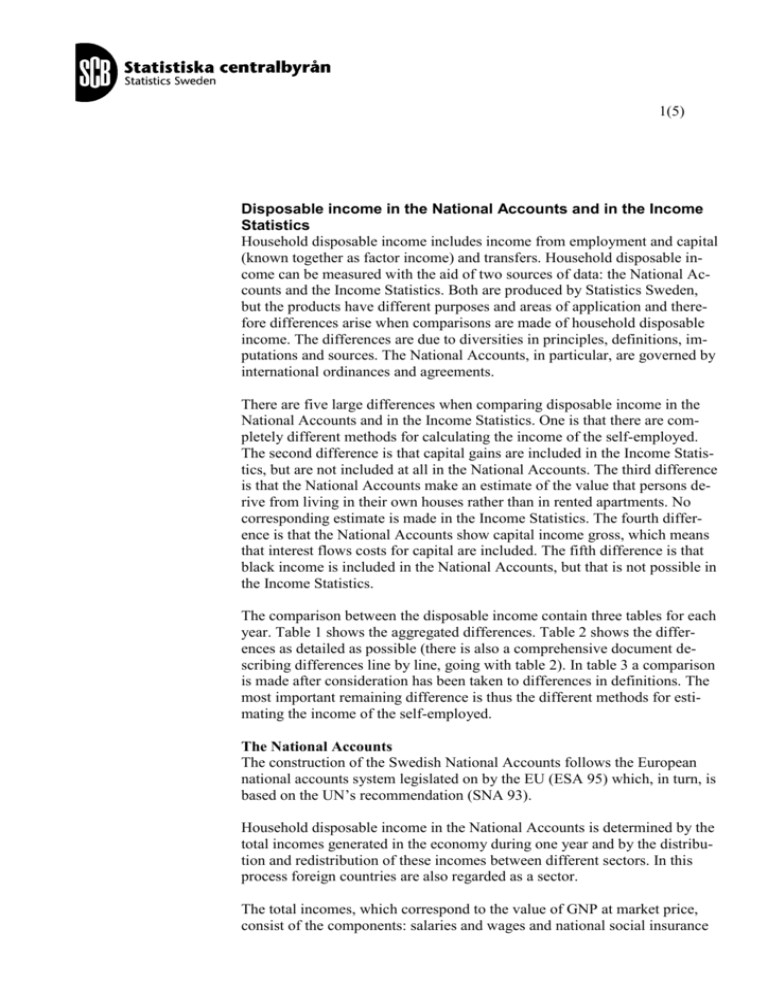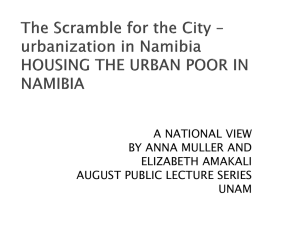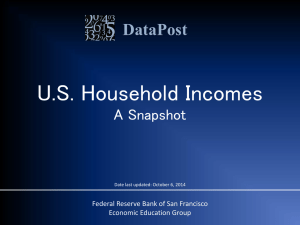Disposable income in the National Accounts and in the Income
advertisement

1(5) Disposable income in the National Accounts and in the Income Statistics Household disposable income includes income from employment and capital (known together as factor income) and transfers. Household disposable income can be measured with the aid of two sources of data: the National Accounts and the Income Statistics. Both are produced by Statistics Sweden, but the products have different purposes and areas of application and therefore differences arise when comparisons are made of household disposable income. The differences are due to diversities in principles, definitions, imputations and sources. The National Accounts, in particular, are governed by international ordinances and agreements. There are five large differences when comparing disposable income in the National Accounts and in the Income Statistics. One is that there are completely different methods for calculating the income of the self-employed. The second difference is that capital gains are included in the Income Statistics, but are not included at all in the National Accounts. The third difference is that the National Accounts make an estimate of the value that persons derive from living in their own houses rather than in rented apartments. No corresponding estimate is made in the Income Statistics. The fourth difference is that the National Accounts show capital income gross, which means that interest flows costs for capital are included. The fifth difference is that black income is included in the National Accounts, but that is not possible in the Income Statistics. The comparison between the disposable income contain three tables for each year. Table 1 shows the aggregated differences. Table 2 shows the differences as detailed as possible (there is also a comprehensive document describing differences line by line, going with table 2). In table 3 a comparison is made after consideration has been taken to differences in definitions. The most important remaining difference is thus the different methods for estimating the income of the self-employed. The National Accounts The construction of the Swedish National Accounts follows the European national accounts system legislated on by the EU (ESA 95) which, in turn, is based on the UN’s recommendation (SNA 93). Household disposable income in the National Accounts is determined by the total incomes generated in the economy during one year and by the distribution and redistribution of these incomes between different sectors. In this process foreign countries are also regarded as a sector. The total incomes, which correspond to the value of GNP at market price, consist of the components: salaries and wages and national social insurance 2(5) contributions, production taxes less subsidies, capital depreciation (depreciation of real capital) as well as operating surpluses and mixed income (see below). Salaries and wages in Swedish production mostly consist of payment for work done by Swedish households. A small part goes abroad and Swedish households also have a certain amount of income from salaries and wages from abroad. The households’ operating surplus mainly consists of incomes received by households from their own houses and holiday houses. Mixed income is the designation given to household income from business activities and partly includes compensation for capital invested in personal enterprises and partly compensation for the work done by the owners in their enterprises. Personal enterprises are included in the household sector. Households also receive income from interest and dividends in the form of returns on capital invested in production in the business sector and, to a small extent, in foreign countries. A generic term for income from salaries and wages, operating surpluses, mixed income, interest and dividends is factor incomes or primary incomes. Household disposable income includes factor incomes and the net value of positive transfers (allowances of various types) and negative transfers (taxes and contributions). These transfers, which mainly take place between households and the public sector, lie within the framework of the total incomes, apart from net transfers abroad. Non-profit institutions serving households (NPISH) are usually reported in the National Accounts together with individuals and the self-employed. Together they constitute the concept “households”. In this comparison, data for National Accounts do not contain NPISH except for in one column in table 1. Income of NPISH is underestimated because there is no information on transactions from individuals to NPISH (membership fees and gifts). For the year 2000 and thereafter, membership fees to the Church of Sweden have been included. The Income Statistics There are two official statistical products in the Income statistics, which describe the income situation of all family units in the country. One is the Income and Wealth Statistics and the other the Household Economy. This comparison has used the structure used in the Household Economy, while the information on amounts has been obtained from the Income and Wealth Statistics. As an overall designation the term “Income Statistics” is used. The Income and Wealth Statistics are produced in annual survey that covers the entire population of Sweden. The statistics are based on tax assessments and statements of earnings and tax deductions provided by the National Tax Board, as well as information from other administrative registers. 3(5) The Income Statistics’ definition of the income concept follows, to a certain extent, the UN’s recommendations of 1997 “Provisional guidelines on statistics of the distribution of income, consumption and accumulation of households”. A review of the UN’s guidelines has been taking place in two groups: one initiated by the EU and a second group, the so-called Canberra group, formed on an initiative from Australia. The groups cooperate with each other and Statistics Sweden is represented in both groups. The Canberra group presented its recommendations in the spring of 2001. Factor income in the income statistics (income from employment and capital) includes salaries and wages, income of the self-employed, benefits from private companies and gross yields on capital. The factor income is determined by the amount assessed for tax purposes. In order to arrive at disposable income, positive and negative transfers are added. Taxable transfers at an approximate level are obtained from tax assessments. Tax-free transfers are obtained from each source. The National Social Insurance Board provides more detailed data on, for example, pensions, sickness benefit, parental benefit and housing allowances. The National Board of Student Aid contributes information on different forms of study payments and so on. Negative transfers mainly consist of taxes debited according to the tax assessments. Differences between the National Accounts and Income Statistics The mixed income in the National Accounts differs considerably from income type self-employed in the Income Statistics. The values shown in the National Accounts are, to a certain extent, the result of reconciliations of the total Swedish economy made within the National Accounts system. The total incomes are determined by the value of GNP, which provides a framework for allocations between different sectors. The allocation of salaries and wages and national social contributions, production taxes and subsidies does not constitute a problem. The allocation of capital depreciation and the operating surpluses created in financial companies and the general government sector can also be estimated satisfactorily. During the last few years the operating surplus in non-financial companies has been estimated with the aid of Statistics Sweden’s business statistics. Mixed income in personal enterprises is obtained thereafter as a final residual. The values provided by this calculation model are almost four times higher for combined earned income than those provided by the Income Statistics, which in turn measure the income of the self-employed as the assessed net income of business and hobby activity. However, neither source provides a good measure of what the entrepreneur really appropriates from the enterprise. The National Accounts use the concept of “personal enterprises”, while the income statistics use “self-employed”. This is due to the fact that different sources are used. 4(5) The National Accounts contain some transactions that are imputed, i.e. they do not exist in reality. One major example is the imputed rental value of one’s own house and holiday house (see also comments to section II line 5). The value of the service of residing in a house, which is produced in owneroccupied housing, shall be included in production (GNP). The reason for this is that comparisons of production and consumption of housing services, over time and between countries, shall not be affected by changes in forms of tenure of rented or owned accommodation. The inflation of incomes that this procedure leads to is matched by an equally large additional amount in household consumption expenditure. Saving in the National Accounts is thus not affected. No corresponding calculation is made for the Income Statistics. Capital gains are not included in disposable income in the National Accounts. In the National Accounts capital gains are not regarded as the result of a productive activity that affects GNP, but as a change in the value of an asset. In the Income Statistics, on the other hand, capital gains reflect an increase in household disposable income. Within the framework of the total reconciliation, an additional amount is also included in the National Accounts for income from salaries and wages that are not given in the statement of earnings and tax deductions (black wages). This additional amount is slightly less than two per cent of the total amount for salaries and wages. There is no equivalent in the Income Statistics. In analogy there is also an direct amount added for black income regarding personal enterprises, which is little less than half the black wages. In the tables, the expression “Black mixed income” is used. One part is the direct amount added and the other is the discrepancy from comparing income from different sectors with each other. The National Accounts do not include study loans in the disposable income, but do include interest payments on these loans. The Income Statistics include the loans but not interest expenses. In general interest expenses are treated as consumption expenditure in the income statistics and thus do not lower the disposable income. The National Accounts and the Income Statistics are partly based on different types of statistical sources. This causes differences to arise. The National Accounts are based mainly on statistics that have not been broken down by individuals, while the sources of the Income Statistics are based on individuals. One example is income from capital. In the National Accounts, interest and dividends are largely estimated on the basis of a model. Information on interest rates for different types of loans are applied to the value of average stocks of deposits and loans. Household income from stocks and shares are calculated on the basis of the proportion of the stocks and shares owned by households. There are statistics on household ownership of shares quoted on the stock exchange, investment funds and foreign shares. There are also sta- 5(5) tistics on the total dividends paid on shares quoted on the stock exchange, total dividends paid by investment funds and dividends received from foreign countries. The proportion of the dividends accruing to households is based on the proportion of the values of stocks and shares owned by households. Reinvested dividends are also included. Capital incomes in the income statistics are obtained from the income tax returns submitted by households. Another example is occupational pensions. The National Accounts obtain data from insurance companies, superannuation funds and the allocations of withdrawals made by non-financial companies from the account ”Provision for pensions”. For general government sector employees, information is obtained from government agencies, municipalities and county councils. Income Statistics obtain information from the statement of earnings and tax deductions and administrative registers. Household transfers to and from abroad are obtained from the Central Bank of Sweden. This is mainly a case of migration currency. Transfers between households and municipalities, such as municipal taxes and social allowances, are obtained from the summary of accounts of municipalities and county councils. The transfers to and from households in the government and social insurance sector consist, among other things, of social benefits such as pensions and social allowances, of taxes and social contributions. Government agencies report though the government accounting system to the Swedish National Financial Management Authority, ESV. Contact persons Elisabet Eklund, Income Statistics, phone: +46 19 17 67 52 Leif Johansson, Income Statistics, phone: +46 19 17 65 41 Mattias Bågling, National Accounts, phone: +46 8 5069 4527 Michael Wolf, National Accounts, phone: +46 8 5069 4563







